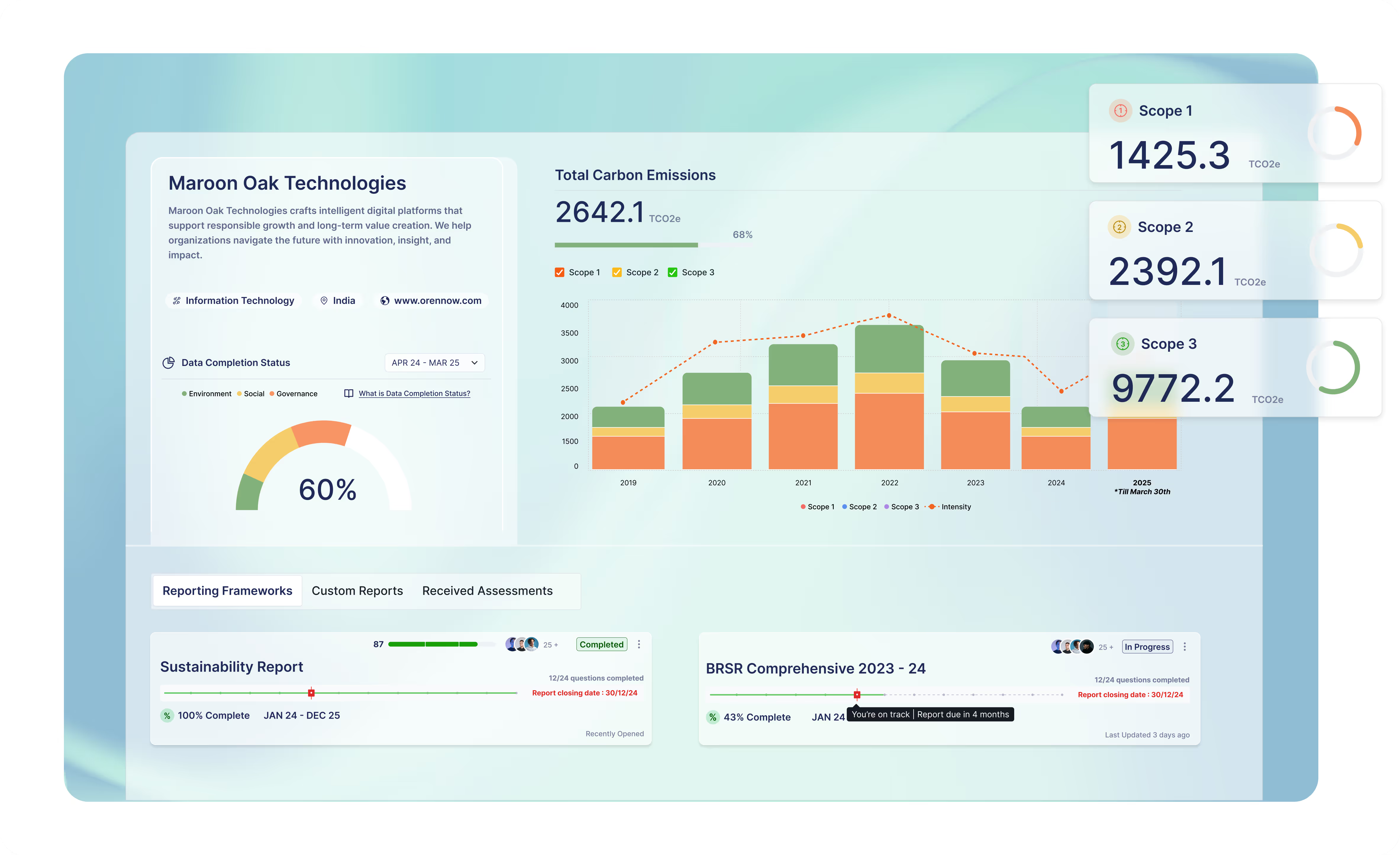BRSR Reporting For India’s Listed Companies Explained

What is Business Responsibility and Sustainability Reporting (BRSR)?
SEBI puts forward a type of report for Indian companies to display their ESG (Environmental, Social, and Governance) performance in a structured and measurable way. This is the Business Responsibility and Sustainability Reporting (BRSR reporting). The framework is comprehensive and a step forward from the earlier Business Responsibility Report (BRR). The report mandates quantitative and qualitative disclosures on responsible practices.
The framework orients Indian businesses with global standards (like GRI, ISSB’s IFRS Sustainability Standards, and TCFD). The approach promotes a company's transparency and accountability. The framework is applicable from FY 2023. It requires the top 1,000 listed companies to report 140 indicators (98 essential and 42 leadership) to cover various ESG aspects. This is how BRSR helps companies integrate responsible business behaviour into their operations and communicate their sustainability performance.
SEBI has also introduced BRSR Core, a simplified version of the framework aimed at helping companies gradually transition to full BRSR reporting. BRSR Core has a phased applicability that initially targets top-listed entities and expands over time.
How is BRSR different from BRR?
The Business Responsibility Report (by SEBI in 2012) became India’s first attempt toward corporate sustainability disclosure. As time passed, there was a need for a more detailed and measurable system. So, the Business Responsibility and Sustainability Reporting (BRSR) framework came into the picture. The BRSR framework is a more structured and data-driven approach than BRR.
What are the Main Disclosure Areas Under the BRSR?
The BRSR framework divides sustainability and ESG disclosures into three core sections: General Disclosures, Management and Process Disclosures, and Principle-wise Performance Disclosures. Each section provides a structured way for companies to communicate their BRSR reporting data clearly and consistently.
General disclosures capture foundational details such as:
- Company information
- Registered offices
- Product and service portfolios
- Employee-related data (diversity, inclusion, and grievance redressal metrics)
Management and process disclosures assess how companies integrate responsible business conduct into their governance structures. These include:
- Board-level oversight
- Leadership statements
- Implementation of policies aligned with the National Guidelines on Responsible Business Conduct.
Principle-wise performance disclosures focus on quantitative BRSR disclosures related to:
- Environmental protection
- Human rights
- Employee well-being
- Ethical business practices
Companies must present measurable outcomes through key performance indicators (KPIs) to show how sustainability is embedded in operations.
Collectively, these disclosure areas ensure transparent, comparable, and credible sustainability information within every annual business responsibility report.
What are the 9 Principles Under the BRSR?
The BRSR framework organises disclosures around nine key principles from the National Guidelines on Responsible Business Conduct (NGRBC). These 9 BRSR principles help companies demonstrate responsible practices and sustainable growth:
Together, these principles help companies present a complete view of their responsible performance in their annual business responsibility report.
BRSR Applicability and Phased Rollout (BRSR Core)
SEBI has mandated a phased rollout for BRSR Core to help listed companies gradually adopt responsible business disclosures. The phased applicability is as follows:
SEBI also encourages other publicly listed companies to adopt BRSR Core or BRSR disclosures voluntarily. This enables organisations to demonstrate responsible business practices, align with ESG goals, and gain a competitive edge. When companies engage in annual business responsibility report filings, they can:
- Proactively manage regulatory compliance
- Showcase sustainability leadership
- Communicate their commitment to stakeholders effectively
BRSR Guidelines by SEBI
BRSR SEBI guidelines are to ensure companies follow a structured and consistent approach to ESG disclosures. These guidelines align with global sustainability reporting standards, such as the Global Reporting Initiative (GRI) and ISSB’s IFRS Sustainability Standards. They are constantly helping Indian companies achieve international comparability and recognition.
Key requirements include:
- Reporting Indicators: Submit both Essential Indicators (mandatory) and Leadership Indicators (voluntary) across all NGRBC principles.
- Essential indicators cover environmental performance, employee well-being, human rights, and community engagement.
- Leadership indicators include greenhouse gas emissions, value chain assessments, energy, and water usage.
- Transparency: Provide clear, complete, and concise responses, along with web-links to supporting documents wherever available.
- Social Disclosures: Cover diversity, inclusion, employee health, and community initiatives.
- Industry Applicability: If a disclosure is not relevant to an industry, companies must explain why.
- Additional Information: Optionally, include any other sustainability-related details to enhance the annual business responsibility report.
Benefits of BRSR Reporting
BRSR reporting helps companies showcase responsible business practices while enhancing transparency and accountability. When companies share clear ESG metrics, their investors and stakeholders make decisions.
Key benefits include:
- Stronger Stakeholder Trust: Transparent disclosures build confidence with investors, customers, and employees.
- Better Risk Management: Companies can identify environmental and social risks early, reducing negative impacts and improving resilience.
- Competitive Edge: Demonstrating sustainability and responsibility helps attract top talent and strengthens brand reputation.
- Global Alignment: BRSR ensures Indian companies conform to internationally recognised reporting frameworks, improving comparability and credibility.
- Driving Sustainable Development: Supports the adoption of sustainable business practices aligned with the UN Sustainable Development Goals.
Overall, BRSR reporting positions companies as leaders in ESG engagement while boosting reporting transparency and accountability in India.
Conclusion
BRSR reporting seems confusing to organisations. All they need is the right guidance, and it will become straightforward. Oren helps companies align with BRSR requirement essentials and complete the Business Responsibility and Sustainability Report BRSR format accurately.
Additionally, the Oren Sustainability Hub, an AI-powered ESG platform, can automate the entire BRSR reporting process. It makes compliance faster, easier, and more accurate.
So, when you are ready with proper reporting, you give your business a full chance to display:
- Responsibility
- Transparency
- Commitment to sustainable growth
Get all of it with zero hassle with Oren!
Frequently Asked Questions
Is BRSR reporting mandatory?
Yes, BRSR reporting is mandatory for the top 1000 listed companies in India by market capitalisation from FY 2022-23 onward.
What is the due date for filing the BRSR report?
BRSR reporting starts from Fiscal Year 2022–23. Applicable companies are required to file or resubmit the BRSR report every fiscal year.
What is the difference between ESG and BRSR?
ESG is a broad concept covering environmental, social, and governance factors globally. BRSR is there as a framework for Indian companies for reporting ESG performance in a structured and standardised format.
What is the difference between GRI and BRSR?
GRI is an international sustainability reporting standard, while BRSR is India-specific. BRSR aligns with global frameworks like GRI but focuses on India’s regulatory and market requirements.
Latest Blog Posts
Dive into our blog for insights on making your organization more sustainable.
Sustainability Simplified
Wherever you are in your sustainability journey, we help you advance with confidence.
Schedule a Call

.avif)


